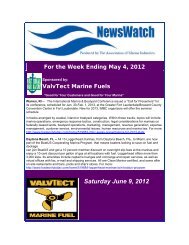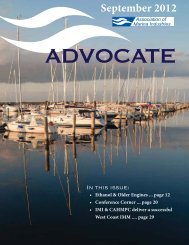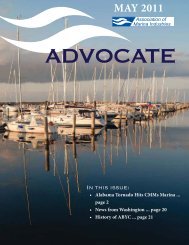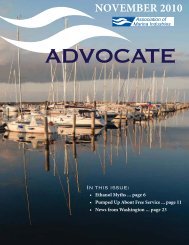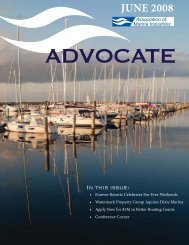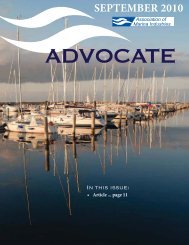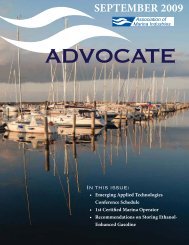Download a copy of AMI's Clean Marina best management practices ...
Download a copy of AMI's Clean Marina best management practices ...
Download a copy of AMI's Clean Marina best management practices ...
You also want an ePaper? Increase the reach of your titles
YUMPU automatically turns print PDFs into web optimized ePapers that Google loves.
Use Upland and Inland Areas<br />
• Upland and inland work areas should be far enough away from the water to allow for the natural filtering<br />
<strong>of</strong> pollutants.<br />
• Locate buildings, workshops, and waste storage facilities in upland areas, away from fragile shoreside<br />
ecosystems, to the greatest extent possible. Upland areas also provide a measure <strong>of</strong> protection against<br />
floods.<br />
• Locate parking and vessel storage areas away from the water, where feasible to reduce run<strong>of</strong>f.<br />
• Consider inland areas for boat repair activities and winter storage. Use hydraulic trailers to quickly and<br />
easily move boats to inland storage locations.<br />
Use Fixed or Floating Piers to Enhance Water Circulation<br />
• Piers, and other structures should not inhibit water circulation.<br />
• Select an open design for new or expanding marinas. Open marina designs have no fabricated or natural<br />
barriers to restrict the exchange <strong>of</strong> ambient water and water within the marina area.<br />
• Install wave attenuators to reduce the force <strong>of</strong> incoming water, if protection is necessary.<br />
• Design new or expanding marinas with as few segments as possible to promote circulation within the<br />
basin.<br />
• Identify options to improve areas with poor water circulation.<br />
Use Environmentally Neutral Material<br />
• For new pilings and other structures that are in or above the water, use materials that will not leach<br />
hazardous chemicals into the water and which will not degrade in less than ten years time; i.e.,<br />
reinforced concrete, coated steel, recycled plastic, plastic reinforced with fiberglass may be preferable.<br />
• Avoid using wood treated with creosote for pilings and similar structures in or above the water<br />
• Purchase floatable foams that have been coated or encapsulated in plastic or wood. As these floats age,<br />
degraded foam is contained by the covering.<br />
Minimize the Need for Dredging<br />
• Locate new marinas in areas where access can be obtained with a minimum <strong>of</strong> excavating, filling, and<br />
dredging.<br />
• Existing marinas that require maintenance dredging more frequently than once every four years should<br />
investigate practicable options to increase circulation or reduce sediment accumulation.<br />
• Extend piers and docks into naturally deep waters.<br />
• Locate slips for deep draft boats in naturally deep waters.<br />
• Dredge channels to follow the course <strong>of</strong> the natural channel.<br />
• Co-locate entrance channels with natural channels.<br />
• Avoid locating the entrance channel perpendicular to the natural channel as shoaling and, therefore,<br />
dredging is a potential problem.<br />
• Where possible, establish two openings at opposite ends <strong>of</strong> the marina to promote flow-through currents.<br />
• Provide dry storage for smaller boats.<br />
Minimize the Impacts <strong>of</strong> Dredging<br />
• Select an appropriate disposal site and containment design. The disposal site must have minimal impact<br />
on public safety, adjacent properties, and the environment.<br />
• Do not dredge during critical migration or spawning periods <strong>of</strong> important species <strong>of</strong> finfish or shellfish.<br />
• Avoid historic water bird nesting areas and waterfowl staging and concentration areas<br />
• Use dredging methods, like hydraulic dredging, that minimize environmental impacts when large dredge<br />
volumes are involved.<br />
• Use turbidity curtains to contain suspended sediments where appropriate.<br />
2



